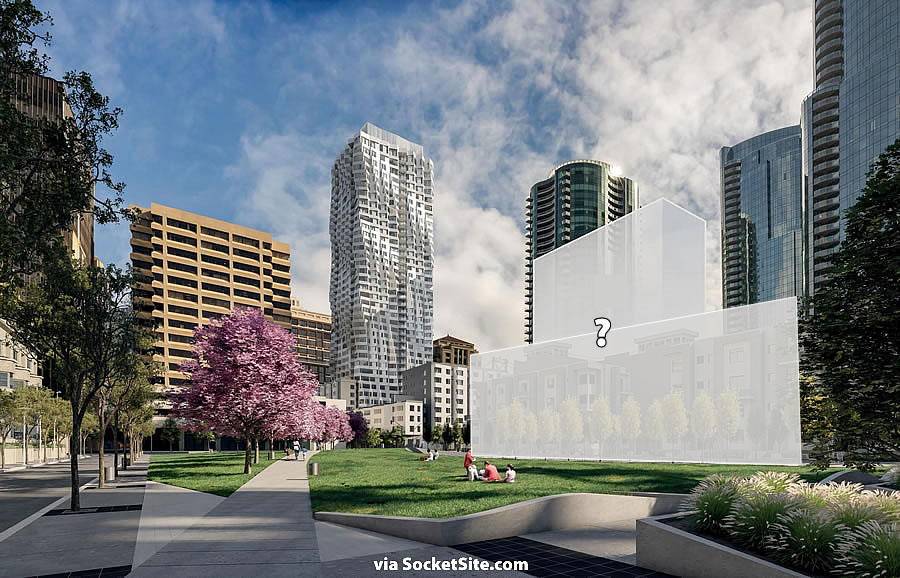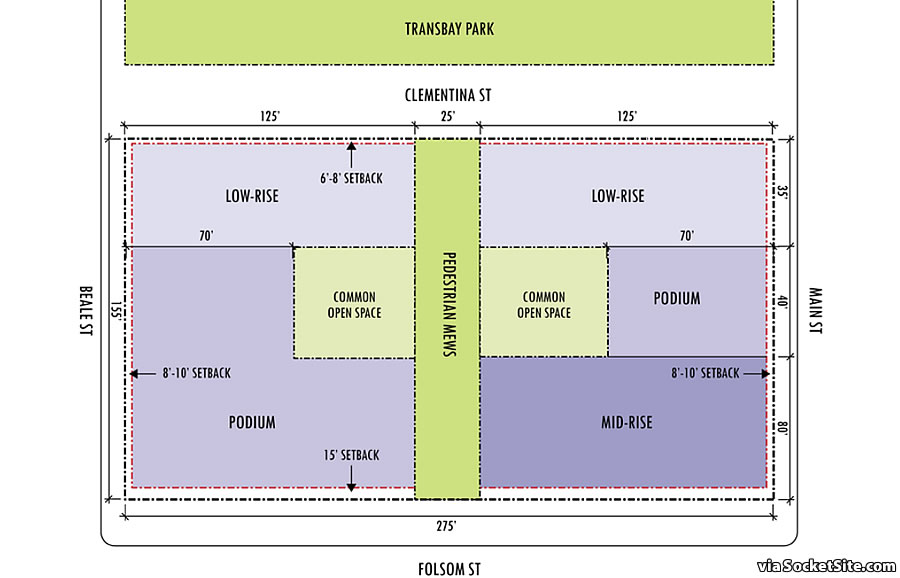Waylaid by the emergency closure and required fix of San Francisco’s new Salesforce/Transbay Transit Center, a refined request for proposals (RFP) to build around 250 units of below market rate (BMR) rental housing on the southern third of the shuttered Temporary Terminal Site, a nearly 43,000-square-foot site bounded by an extension of Clementina Street to the north, Main Street to the east, Folsom Street to the south, and Beale Street to the west, is slated to be released next week.
Expected to yield a mix of one-bedrooms, two-bedrooms and three-bedroom units for families, along with studios and one-bedrooms for seniors, a child care facility, ground floor retail spaces and a mid-block pedestrian mews, the average unit will target households making no more than 80 percent of the Area Median Income (AMI), with an average rent that’s affordable to households making up to 60 percent of the AMI, and 20 percent of the units to be set aside for formerly homeless individuals and households.
As roughly massed below, the development is cleared to rise up to 165 feet in height along Folsom at the corner of Main, with townhomes behind and adjacent to a new mid-block Transbay Park which will occupy the middle third of the Temporary Terminal site.
That being said, according to the draft RFP, project teams will be invited to “consider the possibility that the site could be rezoned to increase the height on portions of the parcel” and provide “a narrative describing the increases in the number of units, feasibility analyses, construction costs and urban design issues associated with a rezoning” if said possibility is proposed.
Assuming the RFP is issued next week, responses will be due in mid-September, the winning team could be identified by the end of the year and the City’s Office of Community Investment and Infrastructure is aiming to have a framework for negotiations and a predevelopment loan agreement in place by February of next year (2021).
We’ll keep you posted and plugged-in.



Somebody (in the Planning Department?) needs to look up the definition of “mews.” You can’t have a mews without horses or stables. What a silly and pretentious label for a path between some buildings.
I’m all for the project, particularly with increased density.
In England, “mews” is often used to refer to a courtyard behind street facing buildings. In the old days, this is where the stables were located. In modern times condos, townhouses, and apartments have replaced the stables.
Yes, I used to live in England so I know what a mews is. Often it’s somewhat literal; the mews behind street-facing buildings was ofte, back in the day, a courtyard in front of the (non-street-facing) stables behind. Today the term is thrown about somewhat more loosely, but it definitely doesn’t apply to a pathway connecting two streets. But you and I may be the only ones who will notice. 😉
Leidesdorff Street still has a bunch of the original downtown horse tie offs. I always wondered why it wasn’t a mews. Tiny stabley street that it is.
Maybe they can put some those historical horse tie offs in. It can be people’s ecological socially distanced transportation solution. 🙂
I wonder if we’ll soon see proposals to re-purpose the current/permanent/TTC…the one that’s all fixed up and serving essentially no one right now. Or maybe I’m being pessimistic about mass transit: just b/c we’re already in Phase 3 – or 2bb ( or something like that ) – and BART is still 88-90% below normal traffic levels is no reason to be discouraged….hey it’s up 50% ( from -93%) right ??
You are being realistic. For several reasons. First off, given the coming major budget shortfalls in the state, HSR will either be cancelled or delayed for decades.
The extension of Caltrain to the TTC is also unlikely anytime soon – look for the “target date” for that to be pushed off by years. The mall under the rooftop park is likely to turn into a white elephant. Seriously, can the mall be repurposed for housing?
On the bright side the TTC is now one of the wonders of the world – the most expensive bus station ever built. It’s funny but really it is sad when one thinks of the wasted resources.
The sharks are circling but one likely outcome of the feeding frenzy is the shifting of HSR funds – to the extent that they exist – into local projects…one of which, of course, could be Caltrain. But does that project still make sense? At what level of reduction in expected patronage does it not? And if the attitude becomes, perhaps sensibly, “let’s wait and see what happens”, then it you’re right…it’s “let’s wait”.
Good question. It depends on the degree to which there is a permanent shift of jobs out of SF (via telework – Twitter, or relocation – UBER/Stripe) and the regional fight over any funds moved from HSR to metro area transit. Santa Clara is going to want a big chunk of the money as are the East Bay counties. And don’t forget BART. The odds are probably against Caltrain coming to the TTC given the massive cost and the somewhat minimal gain.
The Caltrain extension to the TBT makes sense even without HSR mainly due to the huge number of jobs within walking distance from the TBT. From this blog post:
“Not so surprisingly, there is a concentration of jobs in the vicinity of the future Transbay Transit Center, adjacent to the financial district. What is more surprising is just how massive that concentration is: Transbay has more jobs within a half-mile radius (over 100,000) than all the other Caltrain stations combined, from 4th & King all the way down to Gilroy!”.
That may change depending on the longer term effects of Covid. Per SFGate tenants are not renewing their leases and instead choosing to leave the City. Not only are tech firms allowing telework (which could cut a significant chunk out of those 100K workers), they see it as an opportunity to move their companies out of SF.
Yeah, try to live down to your moniker a little more: the premise of this sub-thread is “what if mass transit ridership doesn’t return to pre- levels (at what point do projects cease to be viable..even politically)?”
I don’t think anyone really thinks they’re going to stay at ~90% forever – or even much longer – but the recovery is achingly slow, and the real possibility of – say – a very prolonged one quarter reduction is problematic for an industry that is a perpetual subsidy sponge ..even in good times
What might change is the rent charged to companies for those 100,000 jobs.
Plus, as South Korea, Japan, Hong Kong has shown, you can safely ride transit if everyone wears a mask AND beat coronavirus.
And if you have ever visited South Korea, Hong Kong and/or especially any major city in Japan, you would know that trying to get widespread cooperation and compliance on things like social distancing or universal wearing of masks is a whole lot easier when you are dealing with an overwhelmingly homogenous population that almost all speak the same language and where there is preexisting social cohesion.
Contrast that with S.F. or indeed the Bay Area as a whole where people arrive here from all over the world, speaking any of a dizzying 112 languages, from any one of dozens more cultures with seemingly one thing on their mind: to make as much money in as little time as possible and then leave for greener pastures.
Do you actually ride public transit? Look around you. Are you seeing “everyone wear[-ing] a mask?” If you are, is that due to social cohesion or is it due to the transit operator denying boarding to people not wearing one?
The whole “it’s easy for those countries because they’re homogeneous” is, while not irrelevant, very overstated. This country has a widespread mental disease that make people, Marin liberals and Trumpalo conservatives alike, obnoxiously assert their “independence” by denying basic science and reality itself. That’s what anti-vax Facebook groups and decades of conservative media brain rot does to a population. Notice how Canada, Australia, France, and Germany have had significantly less problem with this kind of stupidity than we do despite having significant minority and immigrant populations. Homogeneity vs heterogeneity is really not the real issue.
Caltrain has always been one of the cleaner Bay Area transit systems, so it might bounce back more quickly. But BART and MUNI have been struggling and losing the public sanitation battle for 20+ years. BART basically gave up even trying to keep things clean before the whole Covid thing started. So I expect it will take a lot longer for those systems to recover.
Singapore does not have a homogeneous population, and they wear masks.
Can the prominent mention of a possible rezoning (upward) of the height limits on the southern block and suggestion for resultant revised RFP’s be read as anything other than a likely downsizing of the significance and nature of the park element of the central block? Kind of like “value engineering.” A real Pity!
Exactly! It was bizarre to put the park mid-block to begin with, where it’s destined to be missed by people on Folsom and Howard, and shaded by *anything* built to the south/southeast. To now encourage further height here makes the “park” that much more meaningless. It’ll be yet another shaded windswept – and empty – plaza.
I agree! It’s not nice to be in a park where there are lots of tall buildings surrounding you. You want to feel a nice open space when you’re at the park. 165 feet for the midrise is already pushing it in my opinion.
I had always thought the medium height envisioned for this parcel *was* taking the park into account, since the buildings across the street are much taller already, so the sun coming down at an angle will be approximately equally blocked by both – in other words, these new buildings don’t really add to any shade the park will already get. now, upzoning further might change that…
The city is facing a $1.5bn budget deficit and wants bmr in a highly desirable locale. Smh.
UPDATE: As expected, the City’s Request for Proposals (RFP) to redevelop Transbay Block 2 has just been released and proposals are due on September 17.
In related news: Refined Timing and RFP to Activate the Temporary Terminal Site
UPDATE: The Draft Plans and New Timing for the Temporary Terminal Site